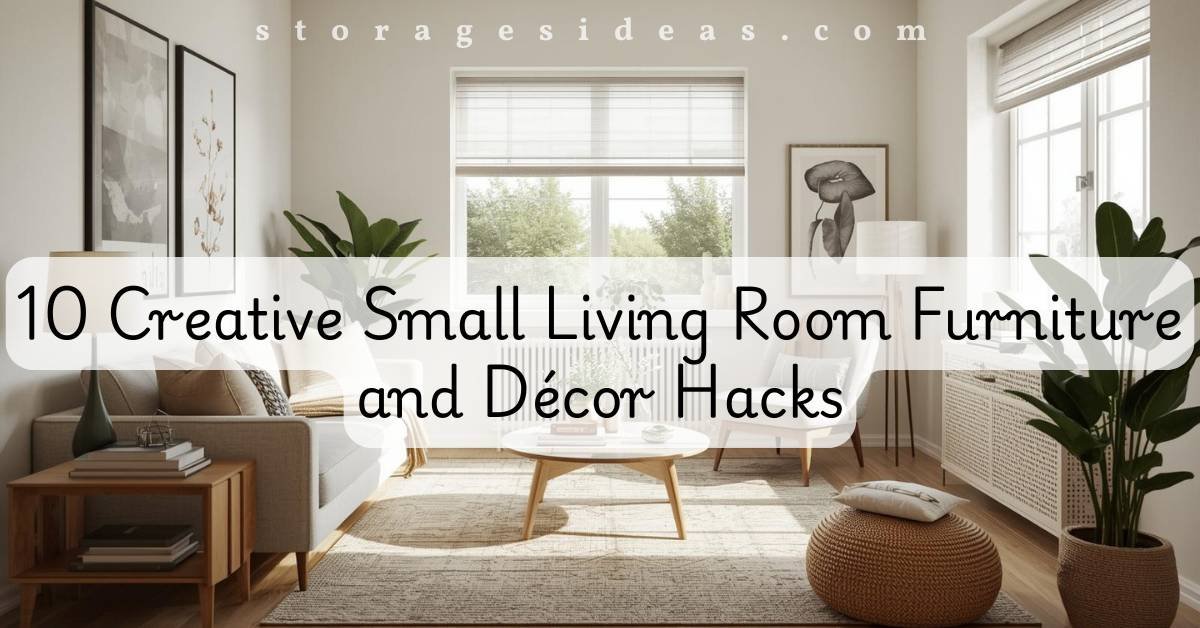A small living room doesn’t have to feel cramped; it can be your coziest, most stylish space yet. The secret lies in how you blend function with personality, making every corner count without losing that inviting charm. Whether you’re refreshing your space for the new season or simply craving a layout that feels bigger, brighter, and more balanced, the right mix of furniture and décor can transform your small living room into a beautifully curated haven.
From clever storage pieces that double as statement décor to subtle color layers that breathe life into tight corners, these small living room furniture and décor hacks will help you design a space that adapts effortlessly, no matter the season. Think timeless textures, versatile pieces, and layout tricks that feel like magic.
So, grab your favorite cup of coffee and imagine your dream living room open, airy, and filled with warmth. By the end of this guide, you’ll know exactly how to make it happen.
In This Guide, I’ll Cover
Toggle1. Choose Multipurpose Furniture That Works Double Duty
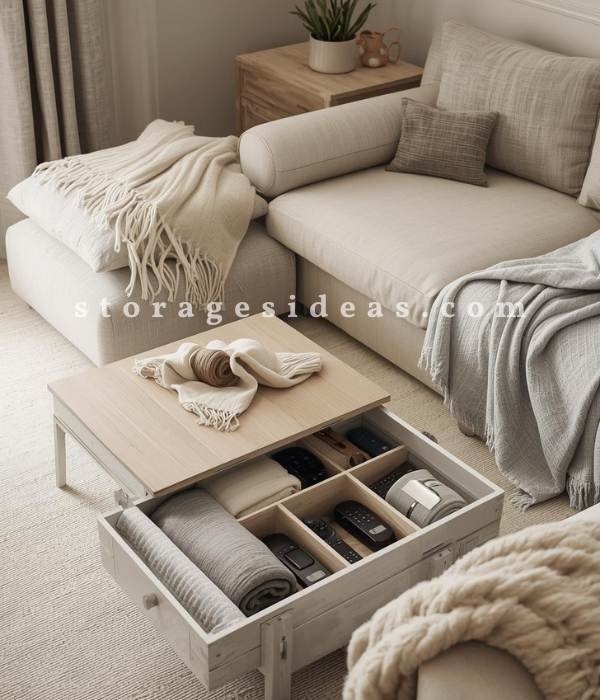
You know that feeling when you sit down, but your eye keeps catching the clutter: a stray remote, a pile of magazines, a blanket dumped on the armchair. In a small living room, those little things add up quickly and steal the calm. That’s why I always recommend investing in pieces that work smarter than they look.
Start with a coffee table with hidden storage, the kind with a lift top or internal compartment. It’s the stealthy hero of the room: store throws, candles, spare chargers, or board games inside, and your surfaces stay clean at a glance. When guests pop over, you can tuck everything away in seconds, and your room instantly reads tidy and intentional.
Next, consider an ottoman that doubles as storage. These are deceptively simple but massively useful. Open the lid and you’ve got a place for throw blankets, children’s toys, extra cushions, or seasonal décor you rotate. Because it looks like seating rather than a storage bin, it keeps the vibe cozy while solving real-life clutter.
And if you want to host but don’t have a spare bedroom, a sofa bed is a must. Modern designs are comfortable to sit on and surprisingly easy to convert into a restful sleeping spot. Look for one with a smooth mechanism and a supportive mattress or memory-foam option; it keeps both your day-to-day comfort and guest comfort top-notch.
Other multipurpose pieces to consider:
- Lift-top coffee tables that double as a laptop desk.
- Modular sofas with storage drawers beneath the cushions.
- Nesting side tables that expand when you need extra surface area, then disappear.
Why these work: each piece reduces surface clutter and multiplies utility without adding visual weight. The result is a small living room that feels lighter and more flexible, ready to switch from lounging to entertaining to hosting guests at a moment’s notice.
2. Go Vertical with Wall-Mounted Storage and Décor
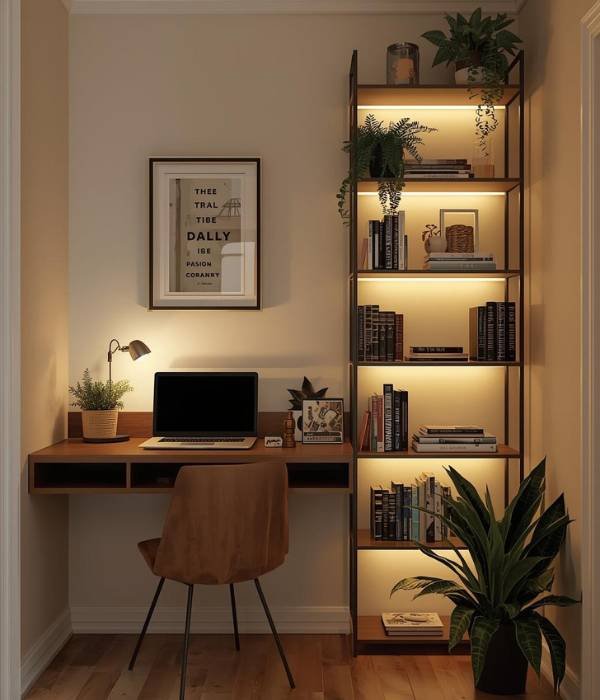
If your floor space feels precious (because it is), then your best move is to give the floor a break and use the walls like extra square footage. Vertical design does more than store; it changes the room’s proportions so ceilings feel higher and the layout feels intentional.
Start with floating shelves. They’re perfect for displaying a curated set of items, a stack of books, a couple of framed photos, and a trailing plant, without the bulk of a bookcase. Keep the arrangement asymmetrical but balanced: a taller item on one end, a small sculpture or candle group on the other, and breathing room in between.
For tighter corners, a tall, slim bookcase draws the eye upward and becomes a visual lift for the whole room. Use it to store items you reach for often on lower shelves (blankets, remotes in a small basket) and decorative pieces higher up. The vertical lines break up horizontal saturation and make the ceiling feel taller.
Don’t forget wall-mounted functionals, slim cabinets, fold-down desks, and mounted pegboards are lifesavers if your living room doubles as a home office. A fold-down desk tucks away your workspace when the day is done; a slim wall cabinet hides office supplies without stealing floor space.
Lighting plays a huge role here, too. Wall sconces or picture lights placed above art create vertical pools of light that draw attention upward and add depth. Even a vertical row of small framed prints or mirrors can make the wall feel like an intentional feature rather than wasted space.
Styling tips to keep it from feeling cluttered:
- Limit each wall display to a visual theme: books + plants, or art + ceramics.
- Leave negative space; breathing room sells sophistication.
- Use repeated materials or colors to tie multiple vertical elements together (e.g., brass frames, wooden shelves).
The payoff: walls that not only store but also elevate your small living room, making it feel architecturally interesting and far more spacious.
3. Use Light Colors and Layered Textures for Depth
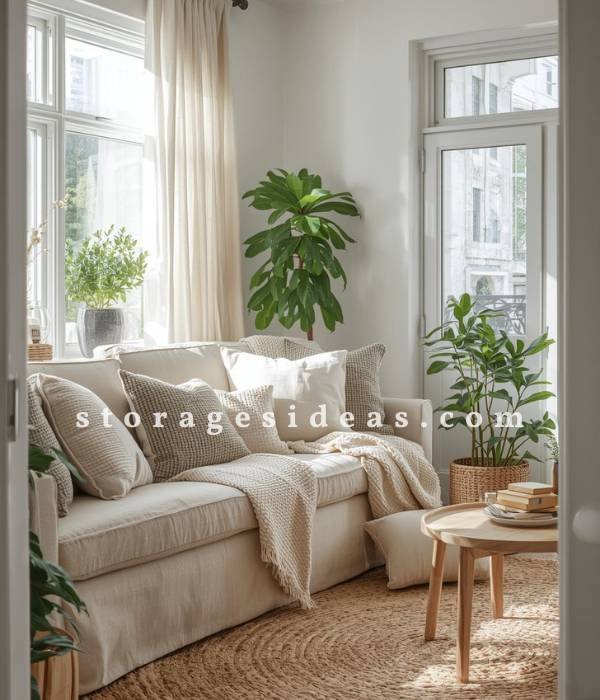
Color and texture are the two easiest tools to transform a small room from cramped to calming. A bright, layered palette tricks the eye into perceiving more space while textures keep the room warm and tactile, never flat or clinical.
Begin with a light neutral base: think warm whites, pale greiges, or soft creams. These hues reflect daylight and create an airy backdrop for everything else. Then add depth through texture rather than bold color. For instance, a linen sofa against a warm-white wall feels fresh; add a bouclé throw and velvet pillows, and suddenly the palette has complexity and comfort.
Here’s a seasonal approach that works beautifully:
- Spring/Summer: swap in linen or cotton slipcovers, lighter-weave rugs (jute or flatweave), and gauzy curtains to maximize air and light.
- Autumn/Winter: move toward warmer textures, chunky knit throws, a plush wool rug, suede or velvet cushions.
Micro-texture swaps make a big difference and are budget-friendly. Replace cushion covers, switch out throws, or layer a lightweight rug over a neutral base rug. Plants also add texture and life. A tall fiddle leaf or trailing pothos introduces organic shape and softens corners.
Lighting and finishes matter too: matte surfaces bounce light differently than glossy ones. Mix finishes (matte wood, soft metal, woven fibers) to create a layered, designer-like feel that reads more expansive than it actually is.
4. Choose Streamlined Furniture with Exposed Legs
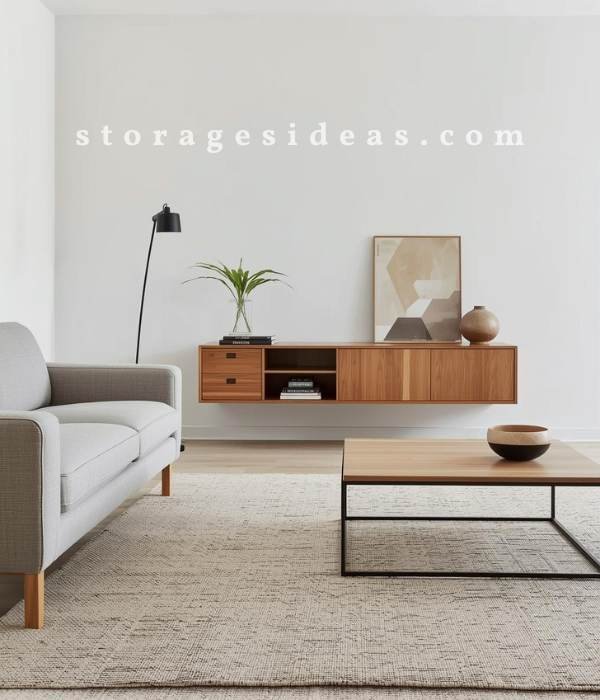
There’s a subtle optical trick in interior design: when you can see the floor under furniture, the room immediately reads larger. That’s why I always nudge people toward streamlined silhouettes with exposed legs; they look lighter and create more visual breathing room.
Picture a slim mid-century sofa with tapered wooden legs. The small patch of floor visible beneath it makes the seating feel less anchored and the whole room more open. The same goes for a floating TV console or a narrow console table with legs instead of a solid base. The visual continuity of the floor helps your eye travel, and when the eye can travel, the room seems bigger.
Practical selection tips:
- Choose sofas and chairs with raised frames and visible legs rather than heavy, boxy bases.
- Look for coffee tables with open lower shelves or thin metal frames instead of solid plinths.
- Opt for wall-mounted storage or furniture with legs so more floor is visible.
Now pair this approach with the multipurpose items we talked about: a coffee table with hidden storage that has a slim profile and legs will give you storage without the weight. An ottoman with a low, legged base keeps the floor visible while hiding blankets or toys. And even a sofa bed with a raised frame looks airier than a low-slung, solid-base sofa bed.
Styling cues: keep the legs in a consistent tone (warm wood or matte metal) to unify the look. Add a low-profile rug that fits under all front legs of the furniture to anchor the layout without chopping up the visual plane.
5. Add Mirrors to Amplify Light and Space
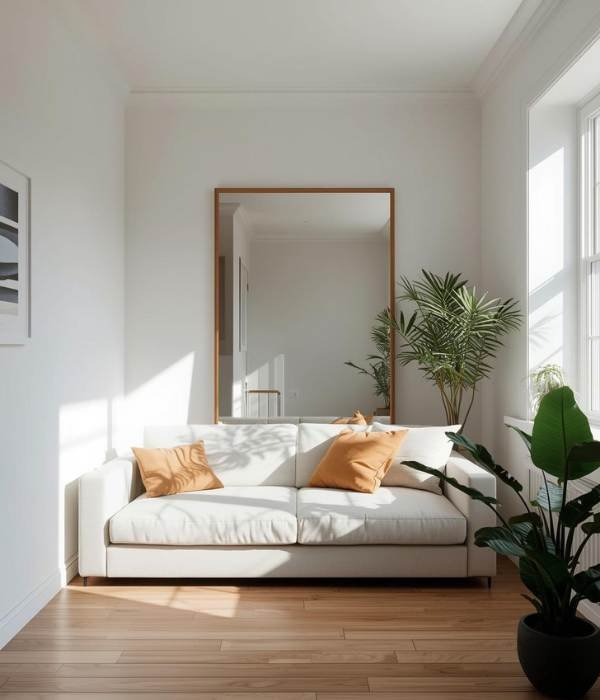
Mirrors are a classic for a reason: they bounce light, double sightlines, and instantly make a compact room feel more generous. But placement and styling are everything; a mirror should look intentional, not like a last-minute addition.
First, find the right spot. Opposite a window is a powerful placement because it reflects natural light and the outdoors, effectively bringing the outside in. If that’s not possible, place a large mirror behind the sofa or lean an oversized mirror against a wall to create depth and height.
Groupings work well, too. A cluster of smaller mirrors in coordinated frames can become an artful focal point that reflects interesting angles of the room. For a soft, eclectic feel, mix shapes and frame textures (brass, wood, matte black), but keep a unifying element like color or scale so it reads cohesive.
Practical mirror uses:
- Make the window work harder: a mirror across from a bright window almost doubles the natural light in the room.
- Create a focal point: Use a statement mirror instead of heavy wall art to keep the area luminous.
- Reflect attractive details: position a mirror to capture and reflect your best styling, a plant, a lamp, or an art piece.
Size matters: a small mirror might look decorative, but a large-format mirror does functional heavy-lifting. If you want a dramatic effect, go tall and lean a full-length mirror propped behind a console or against the wall creates the illusion of another room beyond.
Finally, the mirror finish and frame should match your design language. A sleek frameless mirror suits modern minimalism, while a warm wooden or textured metal frame fits vintage or rustic aesthetics. Done right, mirrors don’t just add light, they elevate the entire room.
6. Play Smart with Lighting Layers
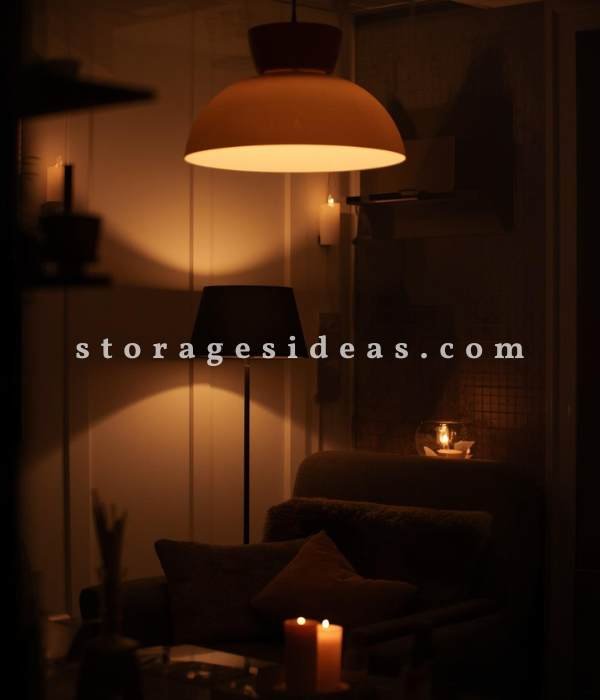
If there’s one thing that instantly changes how a small living room feels, it’s lighting. A single ceiling light rarely does justice to a space this personal. The trick is to layer your lighting so your room looks as good at 10 a.m. as it does at 10 p.m.
Start by defining your lighting zones. Every small living room needs three layers:
- Ambient lighting is your general illumination. This could be a ceiling fixture, recessed lights, or even an LED strip tucked behind a beam or shelf. Choose warm, diffused bulbs to soften the overall feel.
- Task lighting for reading, working, or hobbies. A slim floor lamp beside the sofa or a wall-mounted sconce near your reading nook does wonders.
- Accent lighting for mood and personality. Think fairy lights on a shelf, a candle-lit lantern near the TV unit, or a small table lamp that glows softly in the evening.
Instead of relying on one bright light, this layered approach allows you to control the mood throughout the day. During daylight, ambient lighting should blend seamlessly with natural sunlight. In the evening, task and accent lights bring out texture, depth, and a cozy warmth that makes even small spaces feel luxurious.
Here’s a design tip I swear by: avoid cold white light. It flattens everything. Go for warm (2700K–3000K) bulbs to create that golden, comfortable tone that flatters your décor and your evenings.
And remember: lighting can also style your room. A sculptural floor lamp adds character, while a woven rattan shade brings organic warmth. With good lighting, even the simplest furniture setup can feel magazine-worthy.
7. Use Sliding or Folding Furniture to Save Space
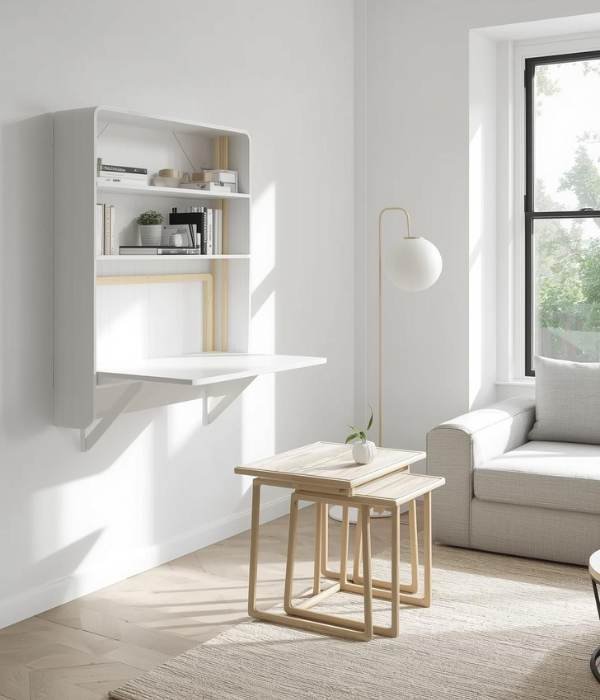
If you’ve ever wished your living room could adapt as quickly as your day does, here’s your solution: sliding and folding furniture. These clever designs are like magic tricks for small spaces, giving you flexibility without clutter.
Imagine starting your morning with a clean, open living area. By afternoon, a fold-down wall desk transforms it into your workspace. When you’re done, it folds back up and disappears into the wall, leaving the room fresh for the evening.
Or maybe you love entertaining. A nesting coffee table set can expand to hold snacks, drinks, or a laptop during movie night, then slide neatly back together when you’re done. Similarly, foldable side tables can live quietly in a corner and appear when guests drop by no need for bulky furniture that stays in the way.
And let’s not forget modular or extendable sofas, which adapt to your seating needs on the fly. Pull-out sections turn into lounges, chaise ends move to either side, and hidden compartments stash away spare cushions.
These pieces embody the small-space mantra: less furniture, more function. They help you keep the layout open and airy while offering everything you need on demand. The trick is to pick styles that align with your décor, sleek, minimal frames, and neutral finishes, so the versatility feels intentional, not improvised.
Small living rooms thrive on adaptability, and folding furniture lets your space evolve effortlessly through every part of your day.
8. Create Visual Flow with Coordinated Décor
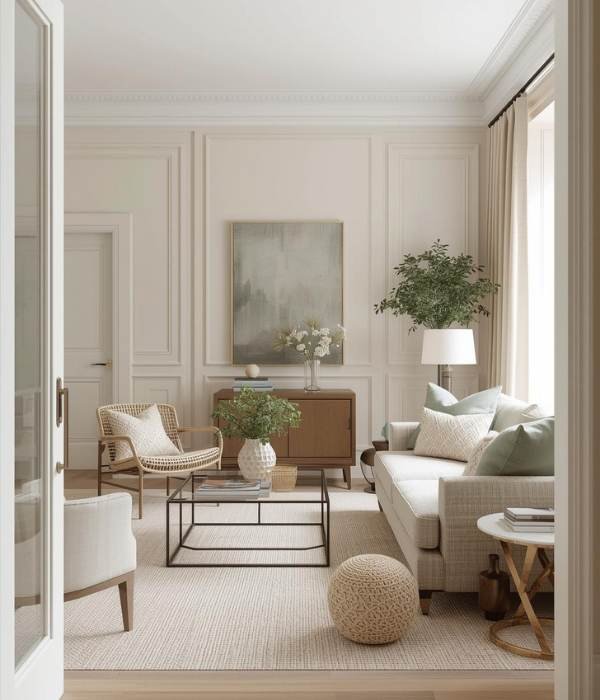
Ever wonder why some small living rooms look so calm and cohesive while others feel busy, even when they’re neat? The secret is visual flow, how colors, shapes, and materials guide your eye across the room.
Start by defining your color palette. Limit yourself to two or three core tones plus one accent color. For example, soft beige, ivory, and a muted sage green create a peaceful backdrop with just enough contrast. Repeat these shades across textiles, artwork, and decorative accents to tie the whole space together.
Choose décor pieces that echo one another, not in a matchy way, but with consistency. If you have a brass lamp base, repeat that warm metallic tone in a photo frame or small vase. If your rug has hints of terracotta, pick up the same color in a throw pillow or candle holder. Repetition creates rhythm, which visually expands the space.
Texture plays a big role here, too. Coordinate your materials: pair linen curtains with cotton cushions, or mix light oak furniture with woven baskets for harmony. Avoid cramming too many patterns into one room; instead, layer subtle ones like thin stripes, small checks, or tonal geometrics for depth without chaos.
Here’s another pro tip: create visual pathways. Arrange furniture so your line of sight naturally moves from one area to another without obstruction. Leave a clear space leading from the door to the seating area, and make sure larger décor elements (like art or mirrors) align with that flow.
When your color palette, textures, and layout work in harmony, the room feels serene, bigger, and professionally styled, even if it’s only a few square meters.
9. Use Glass, Acrylic, or Lucite Pieces for Airiness
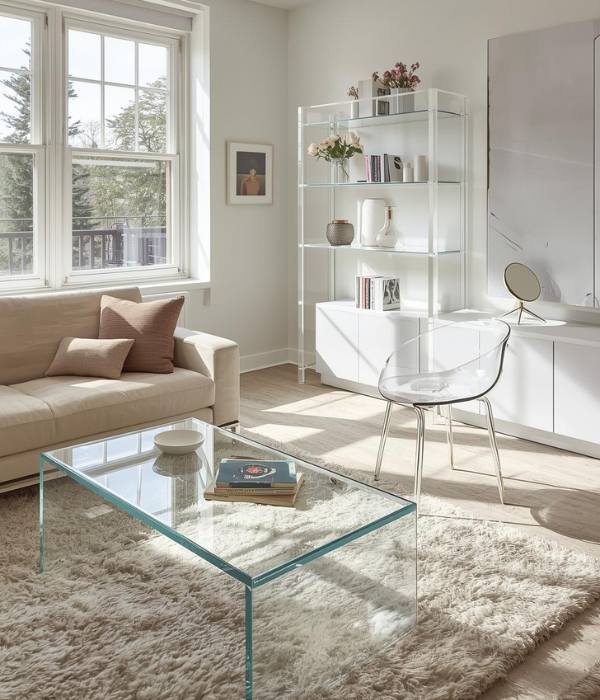
If you’re struggling to make a small living room feel open, transparent furniture might be the ultimate fix. Glass, acrylic, and lucite pieces have an almost invisible quality that gives the illusion of space, like design ghosts that do their job without crowding the room.
A glass coffee table is the classic choice. It anchors your seating area but allows light to pass straight through, so your rug and flooring remain visible in a subtle but powerful way to keep the space airy. Acrylic or lucite side chairs and nesting tables add the same trick, functioning perfectly while keeping the visuals light.
These clear pieces are especially effective when paired with textures that contrast them. Place an acrylic chair beside a plush velvet sofa, or a glass console table on top of a woven jute rug. The interplay of hard and soft textures keeps the room interesting and grounded.
For smaller accents, consider acrylic shelving, clear lamp bases, or even see-through bar carts. They’re functional, stylish, and barely take up visual space.
The goal is to balance too much transparency, and the room can feel cold, so always mix in warmth through natural elements: a wooden picture frame, a ceramic vase, or a soft textile.
The result? A living room that looks larger, brighter, and effortlessly elegant without sacrificing comfort or style.
10. Add Personality with Scaled-Down Statement Pieces
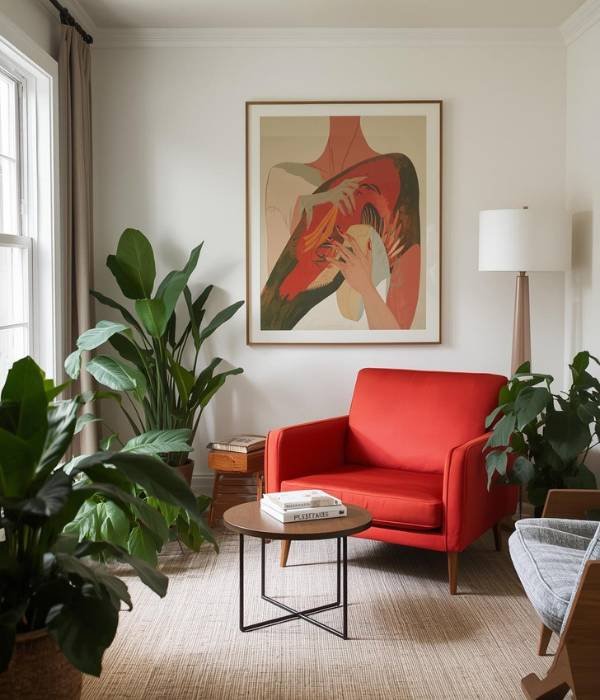
Small space doesn’t mean bland space. In fact, when your square footage is limited, personality becomes even more important; it’s what keeps your living room from feeling generic. The key is to choose statement pieces that fit the scale of your room.
Start with one bold focal point. It could be a striking armchair in a textured fabric or a large piece of art that commands the wall above your sofa. This draws attention where you want it and gives the room a deliberate sense of design.
Another approach is a patterned rug that defines your seating zone. Choose a design that incorporates your accent color, something subtle yet rich enough to add depth. Layer it with simpler furniture so it remains the hero piece without visual competition.
If you’re more into décor accents, let your personality shine through smaller details: a sculptural lamp, a unique side table, or a vintage mirror. Even houseplants can serve as signature elements; a tall indoor tree or trailing vines add organic shape and life.
The trick is restraint. You don’t need five statement pieces, just one or two that capture your aesthetic and anchor the space. Everything else should support them, not compete.
When done right, your small living room feels curated, personal, and complete, the kind of space that reflects you perfectly and welcomes anyone who steps inside.
Final Thoughts: Small Space, Big Creativity
Designing a small living room isn’t about doing less; it’s about doing smart. With the right balance of functional furniture, layered décor, and thoughtful layout, even the tiniest space can feel open, inviting, and full of character.
(Planning for Decor a living room? 10 Small Living Room Fall Décor Ideas might be helpful.)
Each of these small living room furniture and décor hacks is designed to adapt with the seasons: a spring refresh, a cozy autumn setup, or a minimalist winter mood, all without starting from scratch.
(For Further expert tips, check House Beautiful)
Remember: a beautiful home isn’t about size. It’s about how it feels when you walk in. And with these clever small living room furniture and décor hacks, your space will always feel just right, no matter the season.

